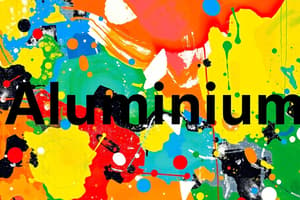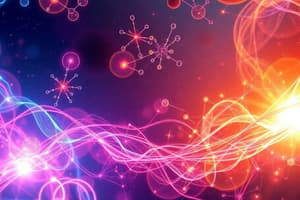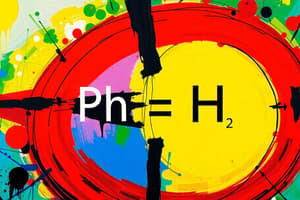Podcast
Questions and Answers
What is an element?
What is an element?
- A substance that reacts differently in chemical reactions
- A substance consisting of one single type of atom (correct)
- A substance consisting of two or more types of atom
- A substance that can be broken down into simpler substances
How are elements represented?
How are elements represented?
- Using chemical formulae
- As simple compounds
- Using chemical symbols (correct)
- By diagram and key
What is a compound?
What is a compound?
- A substance that cannot react in chemical reactions
- A substance consisting of one single type of atom
- A substance made up of two or more types of atom (correct)
- A substance made up of a single type of atom
How are simple compounds expressed?
How are simple compounds expressed?
In ionic compounds, what must be balanced when writing the formula?
In ionic compounds, what must be balanced when writing the formula?
What does oxidation number indicate?
What does oxidation number indicate?
What is the oxidation number of hydrogen in a metal hydride?
What is the oxidation number of hydrogen in a metal hydride?
In a neutral compound, what is the sum of all oxidation numbers according to the rules?
In a neutral compound, what is the sum of all oxidation numbers according to the rules?
What is the oxidation number of oxygen in peroxides?
What is the oxidation number of oxygen in peroxides?
If a compound has a total charge of -1, how do the oxidation numbers in the compound add up according to the rules?
If a compound has a total charge of -1, how do the oxidation numbers in the compound add up according to the rules?
What is the oxidation number of sulfur if it is part of a compound where the total oxidation state must be zero?
What is the oxidation number of sulfur if it is part of a compound where the total oxidation state must be zero?
What must happen to the number of atoms and each type of atom during a chemical reaction?
What must happen to the number of atoms and each type of atom during a chemical reaction?
Why is it important to include state symbols when writing ionic equations?
Why is it important to include state symbols when writing ionic equations?
What do ionic equations primarily show about chemical species?
What do ionic equations primarily show about chemical species?
In writing an ionic equation, why is it necessary for the total charge to remain the same?
In writing an ionic equation, why is it necessary for the total charge to remain the same?
Why is it recommended to start with the full chemical equation before writing an ionic equation?
Why is it recommended to start with the full chemical equation before writing an ionic equation?
What is the role of state symbols in differentiating regular chemical equations from ionic equations?
What is the role of state symbols in differentiating regular chemical equations from ionic equations?
Why is it important to cancel out spectator ions when writing an ionic equation?
Why is it important to cancel out spectator ions when writing an ionic equation?
Flashcards are hidden until you start studying
Study Notes
Elements and Compounds
- An element is a substance consisting of one single type of atom that cannot be broken down into simpler substances in any chemical reaction.
- Elements are represented using chemical symbols.
Simple Compounds
- A compound is a substance that is made up of two or more types of atom that are chemically bound together.
- Simple compounds are expressed using formulae and can also be represented using a diagram and key, showing how the electrons are distributed and shared between the different atoms.
Ionic Compounds
- Ionic compounds are expressed using formulae that contain the ions that make up the compound.
- The overall compound will have a neutral charge (zero), meaning the charges of the separate ions must be balanced when writing the formula.
Oxidation Numbers
- Oxidation number gives the oxidation state of an element or ionic substance.
- Rules for allocating oxidation numbers:
- Oxidation number of an element is zero.
- Oxidation numbers in a neutral compound add up to zero.
- Oxidation numbers in a charged compound add up to the total charge.
- Hydrogen has an oxidation number of +1 (except in metal hydrides where it is -1).
- Oxygen has an oxidation number of -2 (except in peroxides and F2O where it is -1).
- All halogens have an oxidation number of -1.
- Group I metals have an oxidation number of +1.
Chemical Reactions and Equations
- Reactions can be seen as a re-arrangement of the reactant atoms to produce various different products.
- The number of atoms must remain the same throughout, as physical matter cannot be created in the chemical reaction.
- Chemical equations must be balanced to be complete and can be represented using word equations or balanced chemical equations.
- State symbols can be included to help predict what observations might be made from a reaction.
Ionic Equations
- Ionic equations show chemical species as dissociated ions with individual charges.
- The total charge must remain the same during the reaction, so the total charge of the reactants equals the total charge of the products.
- State symbols should be used, as all reactants need to be in an aqueous state to be able to dissociate to ions.
- The best method for writing an ionic equation is to start with the full chemical equation for the reaction, then separate it into the dissociated ions before cancelling the ‘spectator ions’ and re-writing it as an ionic equation.
Studying That Suits You
Use AI to generate personalized quizzes and flashcards to suit your learning preferences.




